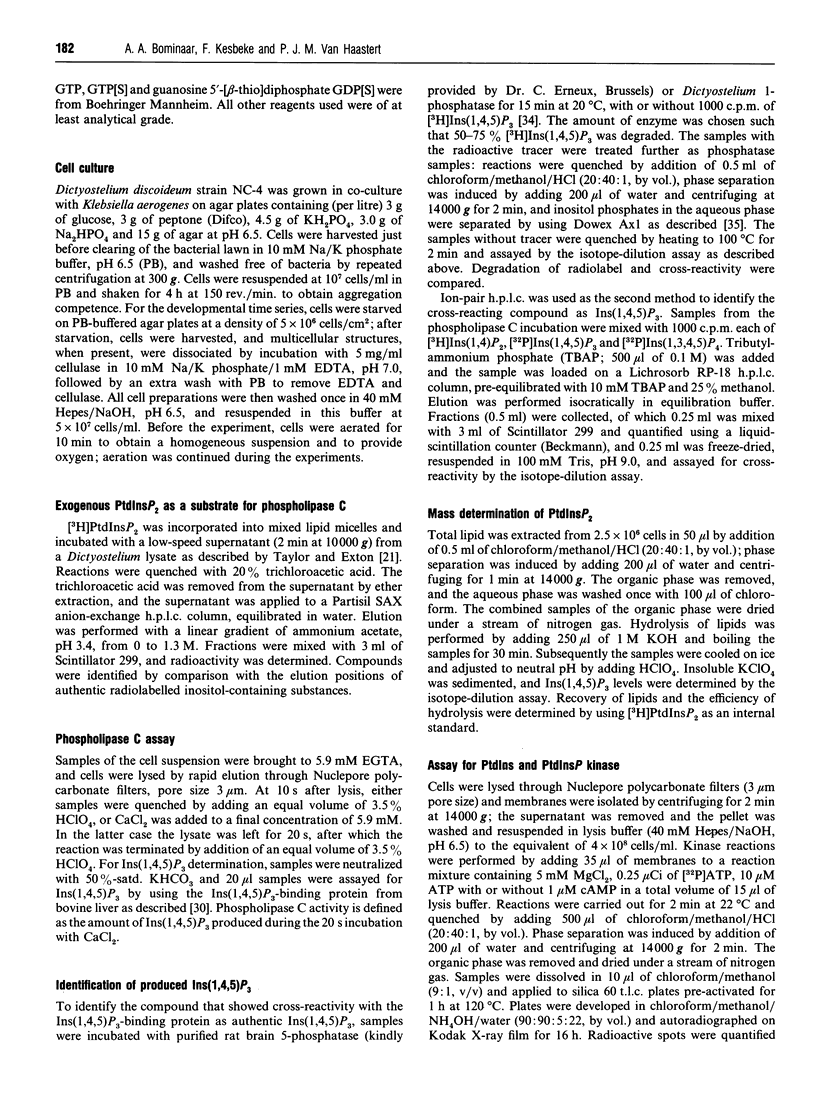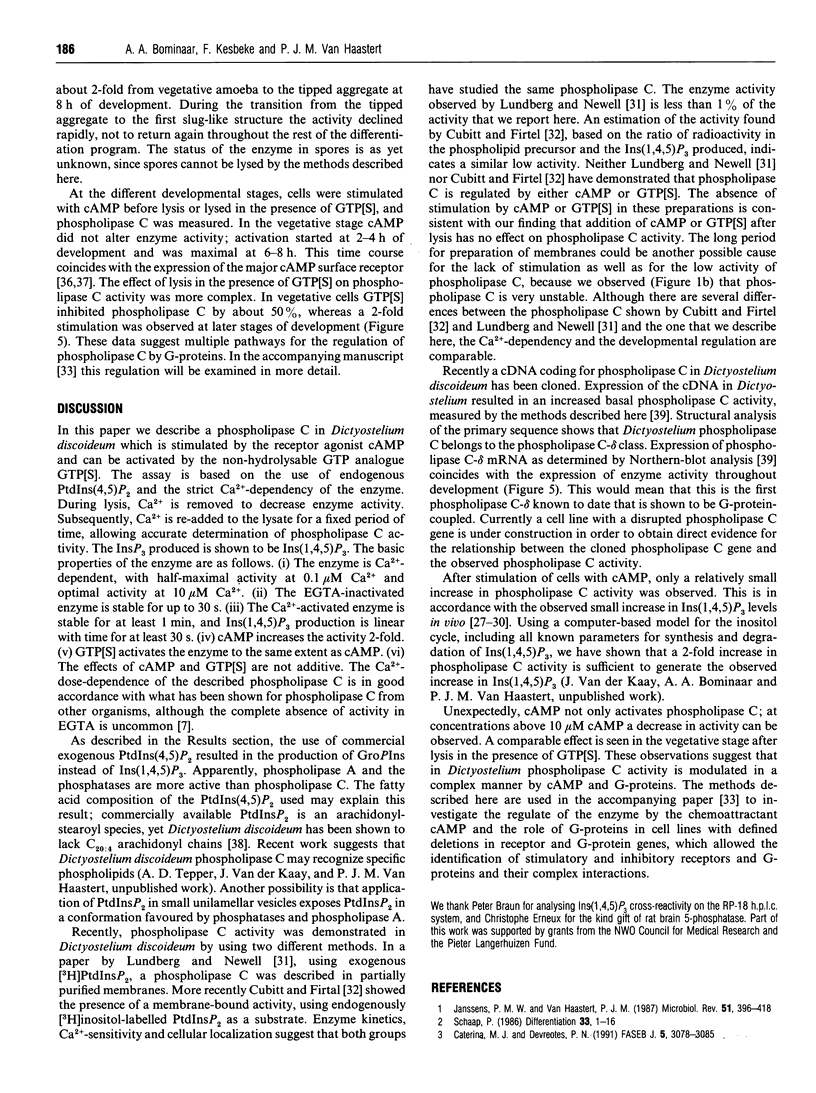Abstract
The cellular slime mould Dictyostelium discoideum shows several responses after stimulation with the chemoattractant cAMP, including a transient rise in cyclic AMP (cAMP), cGMP and Ins(1,4,5)P3. In this paper the regulation of phospholipase C in vitro is described. Under our experimental conditions commercial PtdIns(4,5)P2 cannot be used to analyse phospholipase C activity in Dictyostelium lysates, because it is hydrolysed mainly to glycerophosphoinositol instead of Ins(1,4,5)P3. Enzyme activity was determined with endogenous unlabelled PtdInsP2 as a substrate. The product was measured by isotope-dilution assay and identified as authentic Ins(1,4,5)P3. Since phospholipase C is strictly Ca(2+)-dependent, with an optimal concentration range of 1-100 microM, cell lysates were prepared in EGTA and the enzyme reaction was started by adding 10 microM free Ca2+. Phospholipase C activity increased 2-fold during Dictyostelium development up to 8 h of starvation, after which the activity declined to less than 10% of the vegetative level. Enzyme activity in vitro increased up to 2-fold after stimulation of cells with the agonist cAMP in vivo. Addition of 10 microM guanosine 5'-[gamma-thio]triphosphate during lysis activated the enzyme to the same extent, and this effect was antagonized by guanosine 5'-[beta-thio]diphosphate. These results strongly suggest that surface cAMP receptors and G-proteins regulate phospholipase C during Dictyostelium development.
Full text
PDF






Selected References
These references are in PubMed. This may not be the complete list of references from this article.
- Ashkenazi A., Peralta E. G., Winslow J. W., Ramachandran J., Capon D. J. Functionally distinct G proteins selectively couple different receptors to PI hydrolysis in the same cell. Cell. 1989 Feb 10;56(3):487–493. doi: 10.1016/0092-8674(89)90251-1. [DOI] [PubMed] [Google Scholar]
- Baldassare J. J., Henderson P. A., Fisher G. J. Isolation and characterization of one soluble and two membrane-associated forms of phosphoinositide-specific phospholipase C from human platelets. Biochemistry. 1989 Jul 11;28(14):6010–6016. doi: 10.1021/bi00440a043. [DOI] [PubMed] [Google Scholar]
- Banno Y., Yu A., Nakashima T., Homma Y., Takenawa T., Nozawa Y. Purification and characterization of a cytosolic phosphoinositide-phospholipase C (gamma 2-type) from human platelets. Biochem Biophys Res Commun. 1990 Mar 16;167(2):396–401. doi: 10.1016/0006-291x(90)92035-x. [DOI] [PubMed] [Google Scholar]
- Berridge M. J., Irvine R. F. Inositol phosphates and cell signalling. Nature. 1989 Sep 21;341(6239):197–205. doi: 10.1038/341197a0. [DOI] [PubMed] [Google Scholar]
- Berridge M. J., Irvine R. F. Inositol trisphosphate, a novel second messenger in cellular signal transduction. Nature. 1984 Nov 22;312(5992):315–321. doi: 10.1038/312315a0. [DOI] [PubMed] [Google Scholar]
- Bominaar A. A., Van Haastert P. J. Phospholipase C in Dictyostelium discoideum. Identification of stimulatory and inhibitory surface receptors and G-proteins. Biochem J. 1994 Jan 1;297(Pt 1):189–193. doi: 10.1042/bj2970189. [DOI] [PMC free article] [PubMed] [Google Scholar]
- Caterina M. J., Devreotes P. N. Molecular insights into eukaryotic chemotaxis. FASEB J. 1991 Dec;5(15):3078–3085. [PubMed] [Google Scholar]
- Cubitt A. B., Firtel R. A. Characterization of phospholipase activity in Dictyostelium discoideum. Identification of a Ca(2+)-dependent polyphosphoinositide-specific phospholipase C. Biochem J. 1992 Apr 15;283(Pt 2):371–378. doi: 10.1042/bj2830371. [DOI] [PMC free article] [PubMed] [Google Scholar]
- Deckmyn H., Tu S. M., Majerus P. W. Guanine nucleotides stimulate soluble phosphoinositide-specific phospholipase C in the absence of membranes. J Biol Chem. 1986 Dec 15;261(35):16553–16558. [PubMed] [Google Scholar]
- Drayer A. L., van Haastert P. J. Molecular cloning and expression of a phosphoinositide-specific phospholipase C of Dictyostelium discoideum. J Biol Chem. 1992 Sep 15;267(26):18387–18392. [PubMed] [Google Scholar]
- Emori Y., Homma Y., Sorimachi H., Kawasaki H., Nakanishi O., Suzuki K., Takenawa T. A second type of rat phosphoinositide-specific phospholipase C containing a src-related sequence not essential for phosphoinositide-hydrolyzing activity. J Biol Chem. 1989 Dec 25;264(36):21885–21890. [PubMed] [Google Scholar]
- Europe-Finner G. N., Gammon B., Wood C. A., Newell P. C. Inositol tris- and polyphosphate formation during chemotaxis of Dictyostelium. J Cell Sci. 1989 Aug;93(Pt 4):585–592. doi: 10.1242/jcs.93.4.585. [DOI] [PubMed] [Google Scholar]
- Europe-Finner G. N., Newell P. C. GTP analogues stimulate inositol trisphosphate formation transiently in Dictyostelium. J Cell Sci. 1987 May;87(Pt 4):513–518. doi: 10.1242/jcs.87.4.513. [DOI] [PubMed] [Google Scholar]
- Europe-Finner G. N., Newell P. C. Inositol 1,4,5-triphosphate induces calcium release from a non- mitochondrial pool in amoebae of Dictyostelium. Biochim Biophys Acta. 1986 Aug 1;887(3):335–340. doi: 10.1016/0167-4889(86)90163-1. [DOI] [PubMed] [Google Scholar]
- Fukui T., Lutz R. J., Lowenstein J. M. Purification of a phospholipase C from rat liver cytosol that acts on phosphatidylinositol 4,5-bisphosphate and phosphatidylinositol 4-phosphate. J Biol Chem. 1988 Nov 25;263(33):17730–17737. [PubMed] [Google Scholar]
- Gierschik P., Jakobs K. H. Receptor-mediated ADP-ribosylation of a phospholipase C-stimulating G protein. FEBS Lett. 1987 Nov 16;224(1):219–223. doi: 10.1016/0014-5793(87)80451-9. [DOI] [PubMed] [Google Scholar]
- Janssens P. M., Van Haastert P. J. Molecular basis of transmembrane signal transduction in Dictyostelium discoideum. Microbiol Rev. 1987 Dec;51(4):396–418. doi: 10.1128/mr.51.4.396-418.1987. [DOI] [PMC free article] [PubMed] [Google Scholar]
- Kim H. K., Kim J. W., Zilberstein A., Margolis B., Kim J. G., Schlessinger J., Rhee S. G. PDGF stimulation of inositol phospholipid hydrolysis requires PLC-gamma 1 phosphorylation on tyrosine residues 783 and 1254. Cell. 1991 May 3;65(3):435–441. doi: 10.1016/0092-8674(91)90461-7. [DOI] [PubMed] [Google Scholar]
- Kishimoto A., Takai Y., Mori T., Kikkawa U., Nishizuka Y. Activation of calcium and phospholipid-dependent protein kinase by diacylglycerol, its possible relation to phosphatidylinositol turnover. J Biol Chem. 1980 Mar 25;255(6):2273–2276. [PubMed] [Google Scholar]
- Klein P. S., Sun T. J., Saxe C. L., 3rd, Kimmel A. R., Johnson R. L., Devreotes P. N. A chemoattractant receptor controls development in Dictyostelium discoideum. Science. 1988 Sep 16;241(4872):1467–1472. doi: 10.1126/science.3047871. [DOI] [PubMed] [Google Scholar]
- Lundberg G. A., Newell P. C. Membrane-associated phosphoinositidase C activity in Dictyostelium discoideum. FEBS Lett. 1990 Sep 17;270(1-2):181–183. doi: 10.1016/0014-5793(90)81262-m. [DOI] [PubMed] [Google Scholar]
- Meldrum E., Katan M., Parker P. A novel inositol-phospholipid-specific phospholipase C. Rapid purification and characterization. Eur J Biochem. 1989 Jul 1;182(3):673–677. doi: 10.1111/j.1432-1033.1989.tb14878.x. [DOI] [PubMed] [Google Scholar]
- Melin P. M., Sundler R., Jergil B. Phospholipase C in rat liver plasma membranes. Phosphoinositide specificity and regulation by guanine nucleotides and calcium. FEBS Lett. 1986 Mar 17;198(1):85–88. doi: 10.1016/0014-5793(86)81189-9. [DOI] [PubMed] [Google Scholar]
- Moolenaar W. H., Bierman A. J., Tilly B. C., Verlaan I., Defize L. H., Honegger A. M., Ullrich A., Schlessinger J. A point mutation at the ATP-binding site of the EGF-receptor abolishes signal transduction. EMBO J. 1988 Mar;7(3):707–710. doi: 10.1002/j.1460-2075.1988.tb02866.x. [DOI] [PMC free article] [PubMed] [Google Scholar]
- Nakashima S., Hattori H., Shirato L., Takenaka A., Nozawa Y. Differential sensitivity of arachidonic acid release and 1,2-diacylglycerol formation to pertussis toxin, GDP beta S and NaF in saponin-permeabilized human platelets: possible evidence for distinct GTP-binding proteins involving phospholipase C and A2 activation. Biochem Biophys Res Commun. 1987 Nov 13;148(3):971–978. doi: 10.1016/s0006-291x(87)80227-9. [DOI] [PubMed] [Google Scholar]
- Rhee S. G., Suh P. G., Ryu S. H., Lee S. Y. Studies of inositol phospholipid-specific phospholipase C. Science. 1989 May 5;244(4904):546–550. doi: 10.1126/science.2541501. [DOI] [PubMed] [Google Scholar]
- Saxe C. L., 3rd, Klein P., Sun T. J., Kimmel A. R., Devreotes P. N. Structure and expression of the cAMP cell-surface receptor. Dev Genet. 1988;9(4-5):227–235. doi: 10.1002/dvg.1020090405. [DOI] [PubMed] [Google Scholar]
- Smrcka A. V., Hepler J. R., Brown K. O., Sternweis P. C. Regulation of polyphosphoinositide-specific phospholipase C activity by purified Gq. Science. 1991 Feb 15;251(4995):804–807. doi: 10.1126/science.1846707. [DOI] [PubMed] [Google Scholar]
- Taylor S. J., Exton J. H. Guanine-nucleotide and hormone regulation of polyphosphoinositide phospholipase C activity of rat liver plasma membranes. Bivalent-cation and phospholipid requirements. Biochem J. 1987 Dec 15;248(3):791–799. doi: 10.1042/bj2480791. [DOI] [PMC free article] [PubMed] [Google Scholar]
- Van Haastert P. J., De Vries M. J., Penning L. C., Roovers E., Van der Kaay J., Erneux C., Van Lookeren Campagne M. M. Chemoattractant and guanosine 5'-[gamma-thio]triphosphate induce the accumulation of inositol 1,4,5-trisphosphate in Dictyostelium cells that are labelled with [3H]inositol by electroporation. Biochem J. 1989 Mar 1;258(2):577–586. doi: 10.1042/bj2580577. [DOI] [PMC free article] [PubMed] [Google Scholar]
- Van Haastert P. J. Determination of inositol 1,4,5-trisphosphate levels in Dictyostelium by isotope dilution assay. Anal Biochem. 1989 Feb 15;177(1):115–119. doi: 10.1016/0003-2697(89)90024-9. [DOI] [PubMed] [Google Scholar]
- Van Haastert P. J., Janssens P. M., Erneux C. Sensory transduction in eukaryotes. A comparison between Dictyostelium and vertebrate cells. Eur J Biochem. 1991 Jan 30;195(2):289–303. doi: 10.1111/j.1432-1033.1991.tb15706.x. [DOI] [PubMed] [Google Scholar]
- Van Lookeren Campagne M. M., Erneux C., Van Eijk R., Van Haastert P. J. Two dephosphorylation pathways of inositol 1,4,5-trisphosphate in homogenates of the cellular slime mould Dictyostelium discoideum. Biochem J. 1988 Sep 1;254(2):343–350. doi: 10.1042/bj2540343. [DOI] [PMC free article] [PubMed] [Google Scholar]
- Weeks G. The manipulation of the fatty acid composition of Dictyostelium discoideum and its effect on cell differentiation. Biochim Biophys Acta. 1976 Oct 21;450(1):21–32. doi: 10.1016/0005-2760(76)90295-2. [DOI] [PubMed] [Google Scholar]
- Wilson D. B., Bross T. E., Hofmann S. L., Majerus P. W. Hydrolysis of polyphosphoinositides by purified sheep seminal vesicle phospholipase C enzymes. J Biol Chem. 1984 Oct 10;259(19):11718–11724. [PubMed] [Google Scholar]


